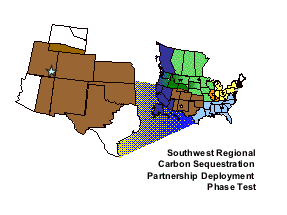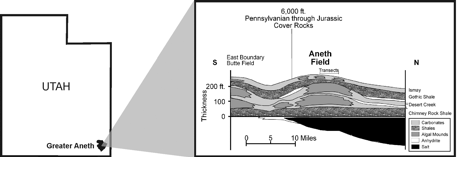Paradox Basin
Southwest
Regional Partnership on Carbon Sequestration —validation Phase
Background
As part of a comprehensive effort to assess options
for sustainable energy systems, the U.S. Department of Energy has selected
seven Regional Partnerships, through its Regional Carbon Sequestration
Partnership (RCSP) Program, to determine the best approaches for capturing and
permanently storing carbon dioxide (CO2), a greenhouse gas which can
contribute to global climate change. The RCSPs are made up of state agencies, universities,
private companies, national laboratories, and nonprofit organizations that form
the core of a nationwide network helping to establish the most suitable
technologies, regulations, and infrastructure needs for carbon sequestration.
Altogether, the Partnerships include more than 350 organizations, spanning 41
states, two Indian nations, and four Canadian provinces.
The Regional Partnership initiative is being
implemented in three phases. The Characterization Phase began in September 2003
with the seven Partnerships working to develop the necessary framework to
validate and potentially deploy carbon sequestration technologies. In June
2005, work transitioned to the Validation Phase, a four-year effort focused on
validating promising CO2 sequestration opportunities through a
series of field tests in the seven regions. In the
future Deployment Phase (2008-2017) actvities will demonstrate that CO2 capture,
transportation, injection, and storage can be achieved safely, permanently, and
economically at a large scale. These tests will promote understanding of
injectivity, capacity, and storability of CO2 in the various
geologic formations identified by the Partnerships. Results and assessments
from these efforts will assist commercialization efforts for future
sequestration projects in North America.
The Southwest Regional Partnership on Carbon Sequestration (SWP)
includes the
states of Arizona, Colorado, Kansas, New Mexico, Oklahoma, Texas, Utah, and
Wyoming. The SWP includes over 50 organizations. The eight states in the
Southwest Regional Partnership account for about 10 percent of U.S. CO2
emissions from stationary sources. The region offers significant potential for
sequestration in saline formations, unmineable coal seams, and depleting oil
and gas reservoirs. Of particular interest is the use of CO2 for
enhanced oil recovery (EOR) in tandem with sequestration.
Project Description
Project Summary
SWP will partner with Resolute Nalural Resources Company and the Navajo Nation Oil and Gas Company ina combined deep saline aquifer - enhanced oil recovery - sequestration pilot test at the Aneth Field in Paradox basin near Bluff, Utah. This test will follow an injection schedule
over 3.5 years, leading up to 136,000 tonnes (150 U.S. tons) of CO2
per year. The primary CO2 sequestration target is the Pennslyvanian Desert Creek and overlying Ismay members of the Paradox formation, the primary producers in the Greater Aneth Field. These
formations are also targets of potential commercial sequestration throughout
the western United States. The SWP plans include a “dual completion” with
injection in two different formations at the same time. By carrying out two tests in two
different formations within the same stratigraphy, portability of science and
engineering results can begin to be evaluated.

Injection Site Description
The Greater Aneth Field is the largest oil field in the Paradox Basin, covering approsimately 48,000 acres in San Juan County, extreme southeastern Utah. The petroleum accumulation is a stratigraphic trap formed by the localized deposition of a large carbonate mound, and possesses a great potential for CO2 storeage subsequest to EOR operations.
Aneth is located on the McElmo-Cortez CO2 pipeline system, and the sheer size of the field makes it a possible target for larger-scale sequestration operations. Petroleum production interests were recently purchased from ChevronTexaco and ExxonMobil, and now these interests are jointly owned by Resolute Natural Resources Company and the Navajo Oil and Gas Company. Both companies operate the field together, and the SWP is pleased to partner with Resolute and the Navajo Nation OGC in a combined enhanced oil recovery (EOR) and sequestration pilot test.
Description
of Geology
The pilot test site is located within the Aneth mound complex (Figure 3), which formed on a weak structural nose. The present-day structural relief of about 150 ft is largely the result of differential compaction. The primary CO2 sequestration target is the Pennsylvanian Desert Creek and overlying Ismay members of the Paradox formation, the primary producers in the Greater Aneth Field. These carbonate strata were deposited on the southwestern flank of the Paradox evaporite basin, and are laterally equivalent to the more basinward anhydrites and salts.
The SWP has gathered porosity, permeability, mechanical, compositional,
and geophysical data associated with these target formations and seals.

Source of CO2
The field has the capacity to take delivery of up to 20 MMCF per day of CO2 and reinjection capacity of a similar amount. The CO2 comes from the McElmo Dome CO2 source and is ~ 98% pure CO2, with < 2% nitrogen and methane. arrives at a pressure of about 2750 psi, which is sufficient to inject it into the wells without compression. Individual well CO2 rates are planned and expected to ba about 300 MCF per day per well. The extension of the CO2 area within the Aneth field will ential at least three phases of development. Resolute will be constructing approximately 50 miles of new flow lines and injection facilities and equipment in each development.
Simulation and Monitoring of CO2
The
project will require extensive monitoring and simulation to determine if the
storage operations are effective in trapping the injected CO2 for
millennia. Vertical seismic
profiling and microgravity methods will be particularly utilized, given their
proven ability to resolve the size of the CO2 plume. Monitoring, mitigation, and
verification (MMV) techniques that will be used include repeat 3-D seismic
surveys, pressure monitoring, groundwater chemistry monitoring, pressure and
fluid sample monitoring from other locations, soil gas sampling, and other
methods. A variety of “in house”
and commercial/public simulation tools will be used, including GEM, TOUGH2,
TOUGHREACT, FEHM, CO2-PENS, COMSOL, THRUST3D, MRKEOS and SWEOS.
Goals and Objectives
SWP’s overall goal is to
validate the information and technology developed under the Characterization
and Validation Phases relative to research and field activities, public
outreach efforts, and regional characterization. Specific objectives include:
·
Develop an overall
methodology that optimizes engineering and planning for future commercial-scale
sequestration projects
·
Conduct successful
large-scale CO2 injection projects targeted at Jurassic and older
sandstone formations
·
Achieve a more thorough
understanding of the science, technology, regulatory framework, risk factors,
and public opinion issues associated with large-scale injection operations
·
Validate MMV activities,
modeling, and equipment operations.
·
Refine capacity
estimates of the target formation using results of the tests
Benefits to the Region
The
SWP’s Characterization and Validation Phase analyses determined that the
region’s point sources emit approximately 320 million tonnes (350 million U.S.
tons) of CO2 per year, which for 100 years (assuming no change in
emissions rate) translates to 32 billion tonnes (35 billion U.S. tons) total
storage capacity needed. The SWP’s Characterization and Validation Phase
analyses provide an initial estimate of capacity of the Pennsylvanian and other oil & gas reservoirs in the Southwest region to exceed 22 billion tonnes (24
billion U.S. tons), over the 50% criterion (Figure 1). The Paradox Basin site, in comparison, is projected to store at least 1.4 billion metric tons of
CO2. During the Deployment
Phase, SWP will continue to refine capacity estimates and evaluate injectivity
and other critical factors relevant to regional storage goals.

